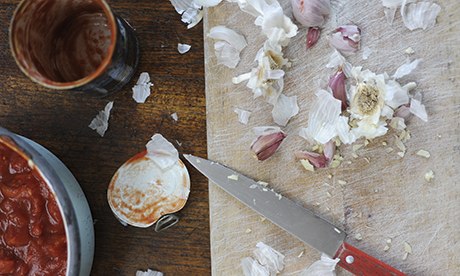
If you can cook a good tomato sauce, you can cook a good anything. To explain why, we must go back to first principles. Bear with me: it will make you a better cook. (Except maybe you, Gordon. You can skip to the recipe.)
Cookery Club has only two principles. The first rule of Cookery Club is: learn to enjoy failure. Making mistakes, things going disastrously wrong – these episodes will be the making of you as a cook. Every great cook's repertoire is built on a mountain of burnt pans. You cannot learn where the boundary is between delicious and not so good unless you go to the dark side. What's more, almost all culinary disasters are still edible. (Tip: if you do burn whatever's in the pan, just pour the contents into a clean pan, making sure not to scrape any of the blackened or slightly browned stuff off the bottom. Then proceed undaunted.)
The second rule of Cookery Club is: learn to trust your taste buds. Slavishly following a recipe and expecting to get a great-tasting dish is like memorising a bike ride and then trying to ride it with your eyes closed.
But everyone knows you have to taste as you cook. The question is: what are you looking for? Scientists now think our tongue has receptors for six discrete flavours: sweet, sour, salty, bitter, umami (or savoury) and, the most recently discovered, fat. The last two – umami and fat, generally provide the "belly" of the dish.
Any tasty dish will achieve a balance between two or more of these flavours. Tomato sauce – although a simple dish – manages three. It is naturally both sweet and sour from the sugar and acid in the tomatoes (though some people like to add a spoonful of sugar for good measure), with a lovely savoury belly (tomatoes are packed with umami flavour, and the olive oil provides fat).
There are two ways to make a tomato sauce – quickly with good fresh tomatoes (we'll wait till summer for that), or long and slow, which brings out their sweet, deep flavour. Jane's recipe is a great example of the latter. She uses plenty of olive oil and lots of garlic for added sweetness.
All-purpose tomato sauce
For basic tomato pasta (and as a base for other sauces), lasagne, pizza bases, or adding to stews for depth of flavour. Can be made in big batches and frozen. (Pour single portions into sealable freezer bags. When you need one, just run the bag under hot water until the frozen contents can be slipped out into a saucepan for reheating.) Will also keep in the fridge for over a week.
Makes about 500ml
2 tbsp olive oil
15 garlic cloves, thinly sliced
2 x 400g tins chopped tomatoes
A pinch of sugar (optional)
3 tbsp extra virgin olive oil
Salt
1 In a large heavy-bottomed saucepan, heat 2 tbsp olive oil for a minute over a low heat. Add the sliced garlic, and stir. Cook for another minute or two, until the garlic is translucent, but try not to let it brown (don't worry if it does, it will still taste good).
2 Add the tomatoes to the saucepan and stir. Turn up the heat so that the mix comes to a simmer (and add a pinch of sugar if you want). Turn down the heat and allow to cook gently for about 40 minutes, stirring occasionally so that it doesn't stick to bottom of the pan. The longer you cook it, the deeper the colour and the flavour will get.
3 Remove from the heat and season with salt (and pepper if you like it). Allow it to cool to a comfortable eating temperature, then stir in 3 tbsp of the extra virgin olive oil.
You can eat it like this, or use a hand blender or food processor to puree it into a smoother sauce.
Recipe by Jane Baxter
The next level
Training your taste buds: salt, fat and acid. Put a spoonful of the warm sauce into a bowl. Add some salt. How does it taste? Add more salt. Taste it. Repeat until it is too salty. Do the same (with a fresh spoonful of sauce) with butter or olive oil. Then sugar. Then lemon juice.
Showing off
This base can be used to create any number of pasta sauces. Some of our favourite things to stir in include: chickpeas and fried chorizo pieces; crisply fried smoked streaky bacon and frozen peas; chunks of aubergine fried in a pan, crumbled ricotta or cream cheese on top; capers and basil; chopped anchovies, a little cream and chopped rosemary; wilted rocket with crumbled feta on top; or chopped basil, a knob of butter, and a little balsamic.
What else can I make?
Basic aubergine parmigiana. Slice aubergines into 5mm slices along their length. Brush with oil and grill until soft (a few minutes). Layer a baking dish as follows – tomato sauce, drained aubergines, slices of mozzarella, grated parmesan. Repeat till you're out of aubergine. Bake at 180C/350F/gas mark 4 for 30 minutes.
Henry Dimbleby is co‑founder of the natural fast-food restaurant chain Leon (@henry_leon). Get your children cooking at cook5.co.uk.

